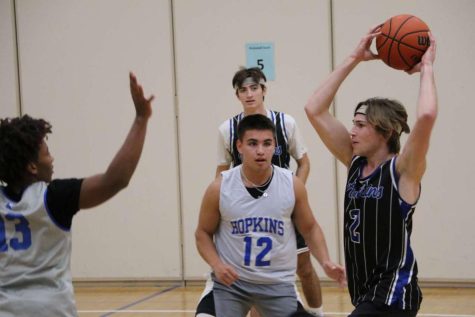Dress code may damage more than it helps
In the Minn. school year, we are haunted by six months of snow on the ground and the ever-lingering desire to crawl out of bed and come to school in our blankets. So in eighth grade, on a 65 and sunny May morning, I just wanted to wear shorts.
After walking into North Junior High, I was told to change from my middle-school Aéropostale jean shorts to knee-length basketball shorts that I got from the nurse’s office. I had to change because my fingertips went past the hem of my shorts.
In eighth grade, I was not wearing shorts with explicit words on them, I was not trying to fit in with a gang, and I was not asking for sex. And I shouldn’t have had to explain myself.
The problem lies in the dress code.
At HHS, the handbook states that, “The dress and grooming of a student becomes the concern of the school if it causes disruption to the educational process or appears offensive or inappropriate to others.”
This begs the question: to whom were my shorts a disruption? Who found my legs so disruptive?
Boys. My Aéropostale jean shorts in eighth grade were disruptive to the educational process. My shorts were so sexy and scandalous that my male peers could not pay attention to their learning process.
The dress code is in place to ensure a protected learning environment for all, but they are missing something: they stopped me on my way to class. They disrupted my educational process by favoring that of my male peers.
Mr. Trenton Lawson, Assistant Principal, acknowledges the need for a dress code to prepare students for the future.
“You’re here to learn how to survive after high school. We feel like it’s extremely important for us as Administration to hold our students to those high standards,” Lawson said.
It is clear that dress code restrictions will not end after graduation.
“I wish that I could wear shorts every day, but there is a professional dress code,” Lawson said.
I do not take issue with a dress code being in place. Especially in high school, It is important to give students the responsibility of representing themselves with appropriate dress.
However, it is explicitly stated in the dress code that, “Cleavage, midriff, back, and undergarments must be covered at all times.”
This, I take issue with.
The problem traces back to the archaic notion that women must “cover up” and take responsibility for the distraction of boys. This is the idea in place in our schools, and, unfortunately, the idea that female students may face in the workplace as well.
Last year, in Nov. 2013, Minnetonka High School Principal David Adney sent out mass e-mails encouraging female students to refrain from wearing leggings and yoga pants in favor of more “modest” dress, saying “Cover your butts up — I’m just going to say it straight up. We’re seeing too much.”
Adney clearly missed the message he truly sent when he said that leggings made girls’ backsides “too closely defined.”
He didn’t spare his male students any exposure to females that they can’t handle or haven’t seen before – in fact, he made them out as animals unable to focus if a girl isn’t covering her butt.
For the female students, Adney is sending the message that they should feel guilty. Guilty for making these animalistic males lose control, and guilty for being confident in their choice of dress
The HHS dress code should detail what is truly not appropriate – clothing with sexually explicit images or jargon, the use of expletives on clothing, images or slogans for illegal substances, or gang-affiliated clothing. This would not include forbidding certain female body parts from being exposed and using words like “disruption” and “covering.”
If these changes were enacted, female students would not be shamed for clothing choices that they personally deem appropriate, and HHS could take the first step in empowering women to change these deeply-rooted notions.

